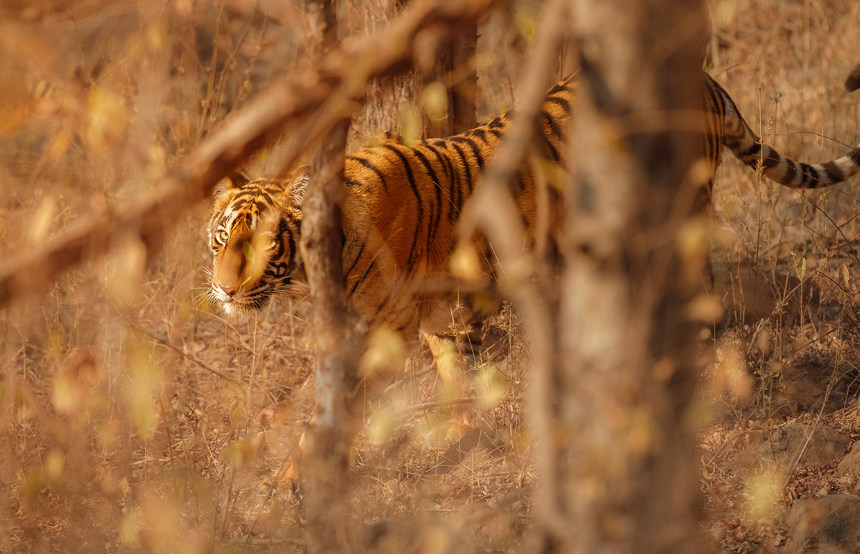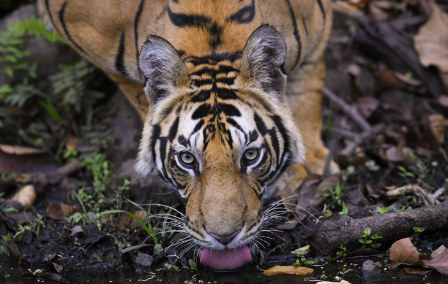Published 5th Sep. 2024
Reading time
African wild dogs are a world apart from our domesticated doggies. Far from being man’s best friend, these ferocious predators have much more in common with wolves (who knew?). Their Latin name – lycaon pictus – even means ‘painted wolf’, but they also go by the name painted dog or cape hunting dog. Keen to learn more about these fascinating animals? While you’ll have to swap your local park for a safari park to see these hounds in their natural habitats, read on for our rundown of the top ten African wild dog facts.
1. Not-quite colossal canines
2. Continental habitats
3. Personalised coats
4. Canine communication
5. Packs’ pups are put first
6. Paw-fect predators
7. Farewell, females
8. Underground homes
9. Heightened hearing
10. Endangered status
1.
They’re no Great Danes, but the African wild dog is still among the largest in the world and is the largest wild canine in Africa. Growing up to 75cm in height and weighing up to 36kg, these cunning canines might not be the biggest mammals on the continent, but they’re solidly built predators nonetheless. It’s no surprise that the dogs have very few natural predators; only occasionally will a young pup end up as a lion or hyena’s dinner.
2.
Once inhabiting the mountains and deserts of most of sub-Saharan Africa, today painted dogs are restricted to southern Africa and southern East Africa only. The dogs are primarily found in savannah woodlands and open plains, preferring grasslands over dense forests. Head to the likes of Zimbabwe, Tanzania, Botswana and South Africa to see the dogs playing, preying and prowling in the wild (from the safety of a 4x4, of course).

3.
Not all African wild dog facts will come as a surprise. But this one might. Although they won’t win prizes for their beauty, African wild dogs’ coats do have one thing going for them: individuality. Much like a human’s fingerprint or a zebra’s stripes, each dog’s coat consists of a one-of-a-kind pattern. Aside from their common black muzzles and white-tipped tails, their marbled brown, black and white fur coats are totally unique. Pretty cool, right?
4.
Ever heard of sneeze decision-making? Us neither. But for our favourite mottled mutts, this is one way that packs make important decisions. New research has shown that a pack will sneeze to cast their vote on decisions like when to go hunting. Other methods of canine communication include touch, action and vocalisation. Maybe it’s time you started paying attention to your dog’s sneezes…
5.
With an alpha male and female breeding pair leading the way, African wild dogs live in packs of up to 40 dogs strong. These sociable animals all muck in to rear the packs’ pups and take on hunting duties. However, this is no doggie utopia, as packs follow a strict hierarchical system that decides who can eat captured prey when and where they’re allowed to sleep. One of the more noble African wild dog facts is that non-breeding adults will even sacrifice their own meals to ensure the pack pups are well-fed and nourished.

6.
While we’ve established that African wild dogs aren’t the biggest on the block, they make excellent hunters. The key to their success? It all comes down to teamwork and endurance. Oh, and they start ‘em young, too, at around 10 weeks old. With a diet of over 70% meat, African wild dogs are known as hypercarnivores, preying on everything from gazelle and impala to zebra and wildebeest. Running at speeds of up to 44mph for as long as an hour, a team of dogs will chase their prey until it tires and then they will begin biting at the prey until it falters. They have an impressive 60-80% success rate for their kills (which is even more than lions can boast).
7.
Unlike most other carnivorous groups, females, rather than males, leave a dog pack upon reaching sexual maturity. Female painted wolves flee the natal nest in search of a new pack to join; this helps to prevent inbreeding and often leads to the eviction of females already established in these newly found packs. These females then follow the same pattern, and voila, the cycle begins anew.
8.
We’ve learnt many habit-related African wild dog facts, but what about their homes? The hairy hounds live in underground dens, which have often been abandoned by other animals. Like any new homeowners, African wild dogs will usually spruce up their new abodes with a revamp. Unfortunately, for most of the pack, when it comes to hitting the hay, it’s likely that only the pups and their parents will sleep underground, with the rest remaining above ground. The den acts as a fortress of protection against predators if there are pups in the pack, and they also change dens throughout the year as a precautionary measure. Clever canines.
9.
Whether you think they’re cute or not, it’s hard to argue that African wild dogs’ ears aren’t their most endearing features. Akin to round satellite dishes, these enormous ears swivel to detect far-away sounds, often listening at a higher frequency than human hearing allows. These elevated ears serve a dual purpose too. Aside from heightened hearing, they also help with temperature regulation, keeping the dogs cool in their hot desert climates.

10.
Now for a sobering end to our list of African wild dog facts. Sadly, they’re an endangered species, and it’s estimated that only around 6,600 remain in the wild. How has this happened? Perhaps unsurprisingly, humans are the main reason behind their dwindling numbers. The dogs rely on large areas for hunting but have lost much of this habitat to human activities. Increased contact with domestic dogs has led to an influx of viral diseases, which can wipe out entire packs, while human retaliation against dogs for killing livestock is also common.
Written by Hannah Whitehall | Header image by Pie Aerts
Practical advice and inspiration for your next trip

Searching for the best safaris in India? We’ve got you covered. Whether you’re keen to track tigers in Madhya Pradesh, admire Asiatic lions in Gujarat or photograph forest eagle owls in Kerala, your India holiday awaits. While Bengal tigers steal the limelight in Bandhavgarh National Park, don’t forget about the shaggy sloth bears (though they’re not as cuddly as they look). Feeling up for the adventure?
15th September 2025 - India Safari & Wildlife

With their sleek, tangerine-tinged coats, piercing eyes and commanding presence, nothing beats the thrill of seeing a tiger in the wild. And where better than in India, home to the largest population on Earth? But when it comes to the best time to see tigers in India, it all depends on what you want from your trip. Whether you’d rather vivid green landscapes or crowd-free safaris, we’ve got the insider intel on when to see India’s famous big cats.
23rd June 2025 - India Safari & Wildlife

Where are the best places for whale watching? We’re glad you asked. From the picturesque Icelandic town of Husavik to the coastal haven of Mirissa in Sri Lanka, there are plenty of destinations to marvel at these majestic creatures. Picture this: the air is still and all you can hear is the creaking of the catamaran and the odd, excited whisper. You scan the horizon, desperate to spot the tip of a fluke or a distant plume of whale breath.
16th June 2025 - Safari & Wildlife

Our team of destination experts will get to know you and your unique requirements for your holiday

We work with you to build an ultra-personalised holiday itinerary with your choice of accommodation, experiences and activities

All of our holidays include little extras designed to make a big difference to your trip, from fast-tracking you through airport check-in and security to our network of local Concierges